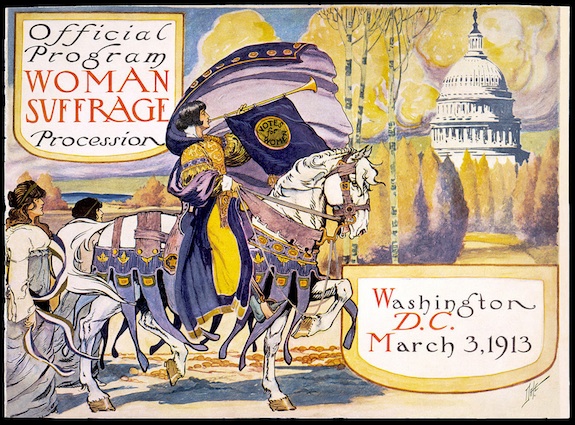Suffragette City: That March that Made and Changed History in D.C. Turns 100
The civil rights procession that revitalized calls for the 19th amendment was the first to use D.C. as a backdrop
![]()

The official program for the 1913 procession. Courtesy of National Woman’s Party Collection, Sewall-Belmont House and Museum, Washington, D.C.
On August 1, 1920, the New York Tribune published a letter to the editor titled “The Case Against Suffrage.” It was from the National Association Opposed to Woman Suffrage and claimed that support for the suffragist movement was significantly overestimated. Unfortunately for the association, just two months earlier, the Senate had approved the 19th amendment, forbidding states to restrict voting rights based on an individual’s sex, and several states were well on their way to ratifying it. By August 18, 1920, Tennessee had became the 36th state to ratify the amendment, satisfying the requirement for enacting it nationally.
Still, another 12 states had yet to ratify the change (Alaska and Hawaii were not part of the country then). Some, like Connecticut came straggling in within the next month, but others, like Mississippi–which approved the amendment on March 22, 1984–waited decades.

Postcard from the march. Courtesy of the American History Museum
One critical step to achieving the ratification of the 19th amendment, according to curator Lisa Kathleen Graddy, was the March 3, 1913 Woman Suffrage Parade. The procession was ”the first civil rights parade to use the nation’s capital as a backdrop, underscoring the national importance of their cause and women’s identity as American citizens.” The parade, held nearly a half century after the Seneca Falls Convention in 1848, was organized by Alice Paul of the National American Woman Suffrage Association and held the day before President Wilson’s inauguration as a means to apply added pressure.
In honor of the 100th anniversary of the historic procession, a new exhibit at the American History Museum shines a spotlight on an event that would prove to be a much longer, and on-going, fight for equality.

Sending a clear message. Courtesy of the American History Museum
“The idea of the parade,” says Graddy, “is to show the contributions of women and the readiness of women to be voters.” Organized by state, as well as profession, the women marching in the parade represented themselves as librarians, writers, homemakers, social workers, actresses, farmers and everything in between. All of this, says Graddy, helped demonstrate that “they already have this huge, vital place in America.”
Check out Megan Gambino’s Document Deep Dive to learn more about the participants of the parade.
Still, some were unpersuaded. One critic said the main issue women were concerned about was Prohibition and since that would work itself out in time there was no other reason women would need to vote, so why bother?
Many were frustrated in the wake of the parade by responses like this. “They thought it would have a more immediate effect,” says Graddy. Nonetheless, the parade is now seen as a critical step in the process. “The parade revitalized the movement for the amendment,” and it showed “women that they could step out onto this street and ask for something, that they could be in public demanding this right.” Graddy says without it, the fight likely would have been left to the states to ratify on their own.
The 30-foot-long display case at the American History Museum captures the energy of the parade with postcards, banners and even cloaks worn by some of the marchers.
/https://tf-cmsv2-smithsonianmag-media.s3.amazonaws.com/accounts/headshot/Leah-Binkovitz-240.jpg)
/https://tf-cmsv2-smithsonianmag-media.s3.amazonaws.com/accounts/headshot/Leah-Binkovitz-240.jpg)